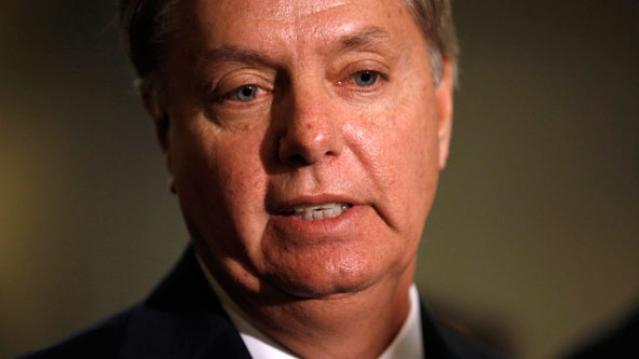Watch Lindsey Graham Destroy His Phone, Get a Bit of Revenge on Donald Trump

What do you do when Donald Trump gives out your cellphone number in a televised campaign rally? South Carolina Sen. Lindsey Graham, a Trump rival for the GOP presidential nomination, made the most of The Donald’s rude move by releasing a video in which he demolishes his phone (more than one, actually) by doing everything short of blowing it up.
Related: 7 Revelations from Donald Trump’s Financial Disclosure
The YouTube video, posted by IJ Review and titled “How to Destroy Your Phone With Sen. Lindsey Graham,” shows the senator smashing a Samsung flip phone in various ways — a golf club, a wooden sword, a cinder block — and also chopping it with a meat cleaver, putting it in a toaster oven with pizza bagels, dropping it in a blender with some Red Bull, lighting it on fire and dropping it from a rooftop.
“Or if all else fails, you can always give your number to The Donald,” Graham says toward the end of the 1:04 clip.
Related: The 2016 Presidential Election Is Already a Dumpster Fire
Graham isn’t exactly a technophile, so maybe he didn’t know he didn’t need to destroy his phone to get a new number (and there are much better ways to get rid of an old phone). More likely, though, the senator found a clever way to take advantage of the attention Trump provided for him and his campaign while also finally upgrading from his flip phone to a smartphone.
Probably getting a new phone. iPhone or Android?
— Lindsey Graham (@LindseyGrahamSC) July 21, 2015
Graham has struggled to make headway in a crowded Republican presidential field, drawing the support of less than 1 percent of registered GOP voters in recent polls. That would leave him off the stage in the Aug. 6 Fox News debate, which is limited to 10 of the 16 candidates. Trump, by the way, is almost assured of a spot. So the senator and his campaign need all the attention they can get — and the new video sure is getting attention. Since it was published to YouTube yesterday, it’s already been viewed more than 1 million times.
Coming Soon: Deductible Relief Day!

You may be familiar with the concept of Tax Freedom Day – the date on which you have earned enough to pay all of your taxes for the year. Focusing on a different kind of financial burden, analysts at the Kaiser Family Foundation have created Deductible Relief Day – the date on which people in employer-sponsored insurance plans have spent enough on health care to meet the average annual deductible.
Average deductibles have more than tripled over the last decade, forcing people to spend more out of pocket each year. As a result, Deductible Relief Day is “getting later and later in the year,” Kaiser’s Larry Levitt said in a tweet Thursday.
Chart of the Day: Families Still Struggling

Ten years into what will soon be the longest economic expansion in U.S. history, 40% of families say they are still struggling, according to a new report from the Urban Institute. “Nearly 4 in 10 nonelderly adults reported that in 2018, their families experienced material hardship—defined as trouble paying or being unable to pay for housing, utilities, food, or medical care at some point during the year—which was not significantly different from the share reporting these difficulties for the previous year,” the report says. “Among adults in families with incomes below twice the federal poverty level (FPL), over 60 percent reported at least one type of material hardship in 2018.”
Chart of the Day: Pragmatism on a Public Option

A recent Morning Consult poll 3,073 U.S. adults who say they support Medicare for All shows that they are just as likely to back a public option that would allow Americans to buy into Medicare or Medicaid without eliminating private health insurance. “The data suggests that, in spite of the fervor for expanding health coverage, a majority of Medicare for All supporters, like all Americans, are leaning into their pragmatism in response to the current political climate — one which has left many skeptical that Capitol Hill can jolt into action on an ambitious proposal like Medicare for All quickly enough to wrangle the soaring costs of health care,” Morning Consult said.
Chart of the Day: The Explosive Growth of the EITC

The Earned Income Tax Credit, a refundable tax credit for low- to moderate-income workers, was established in 1975, with nominal claims of about $1.2 billion ($5.6 billion in 2016 dollars) in its first year. According to the Tax Policy Center, by 2016 “the total was $66.7 billion, almost 12 times larger in real terms.”
Chart of the Day: The Big Picture on Health Care Costs

“The health care services that rack up the highest out-of-pocket costs for patients aren't the same ones that cost the most to the health care system overall,” says Axios’s Caitlin Owens. That may distort our view of how the system works and how best to fix it. For example, Americans spend more out-of-pocket on dental services ($53 billion) than they do on hospital care ($34 billion), but the latter is a much larger part of national health care spending as a whole.





